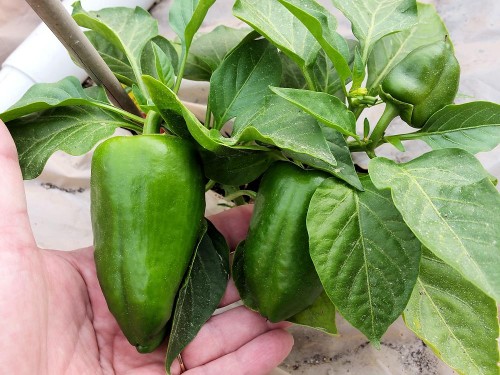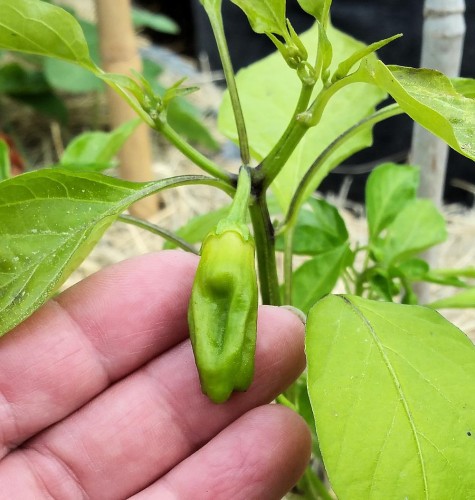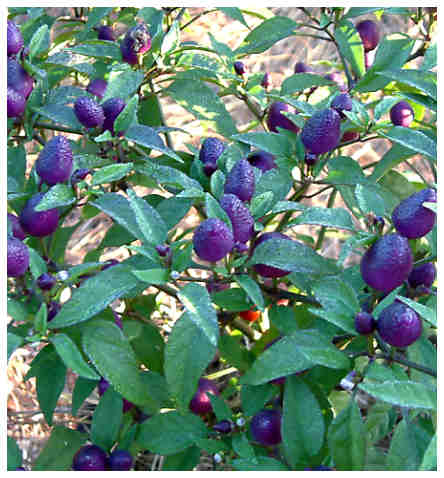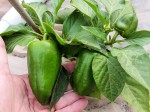Spring 2016 Garden — What’s Growing?
I think I’ve got my lineup set for this year, pepper-wise. I am probably growing far more than I should, and will be overloaded with fruit, but I have neighbors who wouldn’t mind a few peppers from time to time. So what’s in store for 2016?
Fear the Reaper
I have a post where I describe my showdown with the Ghost, Scorpion and Reaper peppers. This is a showdown that will last all year, so subscribe for email updates to keep up with what’s going on with them. But, I don’t just have them growing — let’s take a look at what else is in the garden.
Already Planted

Red Bell Pepper — It Already Has 3 Peppers!
I have the following already planted out in the garden:
- Red Bell: As the name suggests, a red bell pepper — no special variety. It’s a nice compact plant that already has rather large peppers on it! I’ll actually have to pick the largest this week or next, to give the plant a chance to grow some more.
- Orange Bell: I have two of these plants, which are tall and lanky. They both have peppers on them, but I may have to give one of them a pruning, just to compare a pruned plant against an un-pruned. Seems like an interesting comparison.
- Big Bertha: Another bell pepper, and this one supposedly has huge fruit. It will be interesting to see how the fruit compares to the other bells I have growing.
- Shishito: Somewhere between a mild (no heat) and a hot. I hear that most of the fruits have no heat to them, but then every once in awhile, one of the peppers has some kick to it. It also has a pepper already — doesn’t look anything like the bells — it’s more of a small pepperonici as far as general shape goes.

Baby Shishito Pepper
- Havasu: I had no idea what it might be like when I bought the plant start, but I figured with a name like Havasu, it was bound to be at least a little on the spicy side. I finally got around to looking it up, and it’s kind of a stubby banana pepper in shape, and a mild heat. The plant was looking kind of spindly, so I gave it a pruning and it’s coming back beautifully!
- Cowbell: I believe this is supposed to be like a thicker cayenne, along the size of my Yellow Cayenne from the last season I grew peppers. I imagine it’s probably along the same hot-ness as most cayenne fruits. I already gave this one a pruning as well, because it was really lanky. It’s coming back fine, but not as quickly as Havasu (which I pruned at the same time).
From Seed, Waiting to Sprout
Of course I have my “Showdown” peppers that I am growing from seed, but I have a few others as well:
- Jimmy Nardello: A big, sweet pepper. I grew this several years back and thought it was time that I tried it again.
- Mama Mia Giallo: The variety I am growing ripens to yellow, and is supposed to be very sweet. And also quite large!
- Fooled You: This is the no-heat jalapeno I grew in the greenhouse, that succumbed to the black mildrew (or whatever it was). Since I am growing it with better air circulation this year, it should be fine. The peppers were tasty!
- Trinidad Perfume: This one is a no-heat habanero! I figure I have enough Scoville growing this year, with the showdown plants, that I will need some respite! 😉
I might also grow Giant Aconcagua; still trying to decide. I grew that one a few years back as well and it really does produce extremely large peppers for me. I guess it depends on if I have enough space in the garden. I still have a lot of tomatoes, not to mention some strawberries, cukes, summer squash, bush beans, peas, collards and honeydew.
 Tri-Fetti is also on the list; it’s an ornamental pepper that I grow mostly for the foliage, which is lovely. That I know I have room for, at the edge of the garden where I have the flowers. The changing leaf colors are pretty by themselves, but the purple (and then red) peppers add more of an interest. They don’t grow very large, so I can keep them in a 3 gallon pot without an issue. (At any rate, it’s smaller than the Pretty Purple Pepper that I grew a few years back, pictured on the right.)
Tri-Fetti is also on the list; it’s an ornamental pepper that I grow mostly for the foliage, which is lovely. That I know I have room for, at the edge of the garden where I have the flowers. The changing leaf colors are pretty by themselves, but the purple (and then red) peppers add more of an interest. They don’t grow very large, so I can keep them in a 3 gallon pot without an issue. (At any rate, it’s smaller than the Pretty Purple Pepper that I grew a few years back, pictured on the right.)
Now that I think of it — I won’t have a ton of room! But one of the tomatoes is a determinate, so that space should be available by the time the peppers I’ve planted from seed are ready to move outside. The container with the peas (which is 25 gallons) will also be available – I can easily put two pepper plants in there. The collards will also be done, so two more containers!
Anyway, I’ll be providing updates, so stay tuned. As more of the peppers start producing, I’ll start doing some video walk-throughs as well.
Catch up more with you later!
Showdown – Ghost, Scorpion and Reaper Peppers
Time for a pepper showdown! It’s a comparison of Bhut Jolokia (Ghost), Trinidad Scorpion, Carolina Reaper and Jay’s Peach Ghost Scorpion — the hottest peppers in the world. Come and join me?
Bhut Jolokia (Ghost) Pepper
I already have a post from some time ago, where I grew a Bhut Jolokia pepper plant. It was several years ago, and I’ve not re-grown it since. It was rather nice — it grew about 2 feet tall, and was quite bushy. The peppers were a pretty red, and resembled a cross between a habanero and a Fatali pepper. The heat was just over 1,000,000 Scoville. (For reference, the hottest habanero is less than half that, and a jalapeno comes in at about 5,000 Scoville.)
Trinidad Scorpion Pepper
Bhut Jolokia held the title of hottest pepper for a few years, but then the Trinidad Scorpion took the crown in 2012 with approximately 1,200,000 Scoville. This will be the first time I’ve grown the Scorpion pepper, so I am interested to see what I get, for both plant and fruit.
Jay’s Peach Ghost Scorpion Pepper
This is supposed to be a stable cross between the ghost and the scorpion peppers. The pepper is supposed to be larger than either of its parents, The color is different — a more pastel, rather than the brightness of the Jolokia and Scorpion peppers. From the photos I’ve seen, it’s really pretty. The heat is supposed to be somewhere between the two – or so I understand.
Carolina Reaper Pepper
Poor Scorpion — it only held the title of “World’s Hottest Pepper” for one year, because in 2013 he Carolina Reaper pepper took that honor. I tried growing it once, but ran into a bit of a problem and the plant (sadly) didn’t survive. Time I tried again, I think, because the fruit looks quite interesting. It racks up something like 1,400,000 Scoville.
How This Will Work
Unfortunately, or maybe fortunately, this experiment will take awhile. When it comes to these peppers, the seeds take a long time to sprout — somewhere between 3 and 5 weeks, if I recall correctly when I grew (or tried to grow) Bhut Jolokia and Carolina Reaper. I have no reason to doubt that Jay’s and the Scorpion won’t take just as long to germinate.
The showdown will really start once the seedlings are large enough to go out into the garden. I will be comparing:
- Plant height — is it a tall plant or short?
- Plant width — dues it grow up or out?
- Plant vigor — how well does it take to outdoor life? Also, is it a prima donna or is it easy to grow?
- Time to fruit — how long does it take the first fruits to set?
- The peppers themselves — what they look like, how big are they — things like that.
The one thing I will not be comparing is the heat! I am not brave or stupid enough to actually try to eat one of these peppers — habaneros are as hot as I feel comfortable going.
What to Do With the Fruit?
I might try drying some and grinding them to a powder — I’d only need a minuscule amount to heat up a pot of chili or a large bowl of salsa. I probably will go ahead and save some seeds from each of them, though. Before I do, I’ll put some insect netting around the flowers I want to use for the seeds, so I don’t get cross-pollination.
Hmmm, now that I think of it, I may try doing a deliberate cross-pollination fo one flower bunch, just to see what I get. It would be interesting!
 Stay Tuned!
I will be posting throughout the year, with photos — I may try some videos as well, once the plants are large enough. In my little corner of the world (S. Florida), the plants will have a very long growing season — they should be fine up through the first frost. And of the winter of 2016-2017 was anything like 2015-2016, I may be growing these peppers for quite some time!
What’s Growing – Fall 2014 Garden
So, what peppers will I be growing for my Fall 2014 garden in South Florida? Normally I don’t start new pepper plants at this time of year, but this year I have a greenhouse – woo hoo! I’ll be putting it to use with growing peppers, you can bet on that!
Seeing as this will be my first greenhouse — which is probably more like a “grow house” — and I will not have any heating, I don’t want to chance my hotter-than-hot seeds for Carolina Reaper or Ghost Scorpion
. The super-hot peppers take a long time to germinate, plus they like really warm weather. That being the case, I’ll be starting those seeds sometime between Thanksgiving and Christmas.
Still, even though I won’t be starting my super-hots at the moment, I am trialing some other peppers that have struck my fancy.
Peppers On Deck for Fall 2014
I’ll be growing a mixture of bell, no-heat and ornamental peppers this Fall and Winter. They are as follows:
- Flamingo
: This is a bell pepper hybrid, which turns multiple colors on the way to ripening. It appears to start out as an ivory color, then moves to orange and then red. Should be interesting!
- Trinidad Perfume
: This is one of the no-heat peppers. It’s supposed to taste like a habanero, but without the heat. Given that I only know what the heat of a habanero is like (and not the taste, LOL), I am looking forward to sampling this one.
- Sweet Datil
: I love datil peppers, and this is the first time I have seen them with the wonderful taste, but without the heat. Hooked by the description, I just had to buy ’em so I could try ’em. 😉
For the ornamentals, I am trying out:
- Sangria
: Upright peppers that are between 2 and 3 inches on a short plant. Peppers appear to start off purple and move to red when ripe. No heat, so great for areas where kids or pets might brush against them.

- Explosive Ember
: This is a purple pepper that ripens to red. The two big differences between Explosive Ember and Sangria are that Explosive Ember has purple-tinged foliage (Sangria is green), and Explosive Ember is hot.
- Black Pearl
: Another purple pepper / purple foliage plant with hot peppers. These peppers are round (thus the “Pearl”), while EE is cone-shaped.
- Pretty in Purple
: A long-time favorite of mine (see photo on the right, from the last time I grew it), I want to see how the others above stack up against this wonderful pepper plant. In addition to the purple-tinged stems and new foliage, the peppers are hot!
Of course I have just planted the seeds, so I won’t have any pictures for a bit. Stay tuned!
